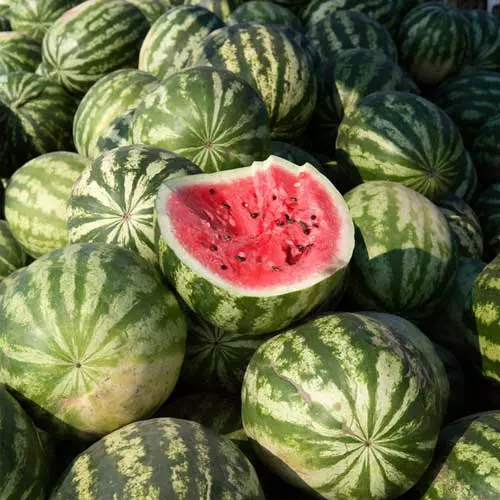How to Grow Watermelons
Watermelons are a popular summer fruit that can be enjoyed in a variety of ways, from refreshing slices to delicious sorbets and smoothies. Growing watermelons at home can be a rewarding experience and can help you enjoy the freshest and most delicious fruit right from your garden. Here’s a guide on how to grow watermelons at home.
Choosing the Right Variety
The first step in growing watermelons is choosing the right variety. There are many different types of watermelons, and the variety you choose will depend on your climate, growing season, and personal preference. Some popular varieties include:
- Crimson Sweet: Crimson Sweet watermelons are a popular variety of watermelon known for their large size and sweet, juicy flesh. They are oblong or round in shape, with a dark green rind that is striped with lighter green. The flesh inside is typically bright red with black seeds, although there are seedless varieties available. They are known for their high sugar content, which makes them particularly sweet and flavorful. They also have a crisp texture and high water content, making them a refreshing fruit to eat on a hot day.
- Sugar Baby: Sugar Baby watermelons are a small, round variety of watermelon that are known for their sweet, juicy flesh. They typically weigh between 6 and 10 pounds and have a dark green rind that is hard and tough, which helps to protect the flesh inside. The flesh of a Sugar Baby watermelon is deep red in color and contains small black seeds. It is sweet and juicy, with a texture that is both firm and tender. Sugar Baby watermelons are often described as having a classic watermelon flavor, with a balance of sweetness and refreshing juiciness.
- Jubilee: This is a large, oblong watermelon variety with a thick rind and sweet, juicy flesh.
- Charleston Gray: This is a popular heirloom variety with a tough, gray-green rind and juicy, sweet flesh.
Preparing the Soil
Preparing the soil for watermelons is an important step in ensuring a healthy and productive crop. Here are some steps you can take to prepare the soil for planting watermelons:
- Choose the right location: Watermelons prefer full sun and warm soil, so choose a location that receives at least 6-8 hours of direct sunlight per day and has well-draining soil. Avoid planting in areas that are prone to flooding or have poor drainage.
- Test the soil: Test the soil to determine its pH level and nutrient content. Watermelons prefer a pH level between 6.0 and 7.0. If the pH is too low, add lime to raise it. If it is too high, add sulfur to lower it. If the soil is lacking in nutrients, add compost or a balanced fertilizer to improve its fertility.
- Clear the area: Clear the planting area of weeds, rocks, and debris. Watermelons require a lot of space, so be sure to remove any competing plants or obstacles.
- Till the soil: Use a tiller or garden fork to loosen the soil to a depth of at least 12 inches. This will improve drainage, aeration, and root penetration.
- Add organic matter: Add a layer of organic matter, such as compost or well-rotted manure, to the soil surface. This will improve the soil’s fertility and structure, as well as help retain moisture.
- Create planting mounds: Watermelons prefer well-drained soil, so create planting mounds by forming hills or ridges. This will help prevent water from pooling around the plant roots and promote good drainage.
- Mulch the soil: Mulching around the base of the watermelon plants with organic matter, such as straw or leaves, can help retain soil moisture, suppress weeds, and regulate soil temperature.
By following these steps, you can create a healthy, nutrient-rich soil environment that will promote the growth and productivity of your watermelon plants.
Planting Watermelon Seeds
Watermelons are typically grown from seeds, and you can either start the seeds indoors or sow them directly in the garden. If starting seeds indoors, plant the seeds in peat pots or seed trays about four to six weeks before the last frost date in your area. When planting outdoors, wait until the soil temperature is at least 70 degrees Fahrenheit before planting the seeds.
Plant the seeds about an inch deep and 3-4 feet apart, with rows spaced 6-8 feet apart. Cover the seeds with soil, and water them well. Watermelons need plenty of water, especially during the germination and early growth stages. Make sure to keep the soil moist, but not waterlogged.
Caring for Watermelons
Watermelons require regular care to ensure they grow healthy and productive. Here are some tips on caring for watermelons:
- Watering: Watermelons need regular watering, especially during hot, dry weather. Water the plants deeply, at least once a week, and make sure the soil stays consistently moist. However, avoid overwatering, as this can lead to root rot and other problems.
- Fertilizing: Watermelons are heavy feeders and require regular fertilizing to produce healthy, sweet fruit. You can fertilize the plants with a balanced fertilizer once a month, or use a slow-release fertilizer at planting time.
- Mulching: Mulching around watermelon plants can help conserve moisture, suppress weeds, and regulate soil temperature. Use organic mulch, such as straw or shredded leaves, and apply it to a depth of 2-3 inches.
- Pruning: Watermelon plants can grow large and sprawling, so it’s important to prune them to prevent overcrowding and ensure good air circulation. Prune off any suckers or side shoots that emerge from the main stem, and remove any damaged or diseased leaves.
- Pest control: Watermelons are susceptible to a variety of pests, including cucumber beetles, aphids, and squash bugs. To control these pests, use insecticidal soap or neem oil, or try natural pest control methods such as introducing beneficial insects like ladybugs or lacewings.
- Harvesting: Watermelons are ready to harvest when the fruit is fully mature and the underside of the fruit has turned yellow or cream-colored. You can also check for ripeness by thumping the fruit with your finger – a ripe watermelon will have a hollow sound. Cut the fruit from the vine using a sharp knife or shears, leaving a few inches of stem attached.
Companion Planting for Watermelons
Companion planting is the practice of planting certain plants together to improve growth, deter pests, and enhance flavor. Here are some companion plants that can be beneficial when planted alongside watermelons:
- Beans: Beans are another excellent companion plant for watermelons. They add nitrogen to the soil, which is beneficial for the watermelon plants, and their climbing habit allows them to grow up the same trellis as the watermelons.
- Radishes: Radishes can be planted as a companion plant to watermelons because they help to repel cucumber beetles, which can be a common pest for watermelon plants.
- Sunflowers: Sunflowers can be planted alongside watermelons to provide shade and support for the watermelon vines. They also attract pollinators like bees and butterflies.
- Nasturtiums: Nasturtiums are a popular companion plant for many types of vegetables, including watermelons. They can help to repel pests like aphids and squash bugs, and their vibrant flowers add color and interest to the garden.
- Marigolds: Marigolds are another popular companion plant for many vegetables, including watermelons. They can help to repel pests like nematodes and aphids, and their strong scent can help to mask the scent of the watermelon plants, making them less attractive to pests.
Remember to give enough space between the companion plants and watermelon vines to avoid competition for nutrients, water, and sunlight.
Plants to Avoid
While there are no plants that are known to be harmful to watermelons, there are some that may compete for nutrients and resources, or attract pests and diseases that can affect watermelon growth. Here are some plants that are best avoided when planting watermelons:
- Cucumbers: While cucumbers and watermelons are both members of the Cucurbitaceae family, they should not be planted together because they can attract the same pests and diseases, such as cucumber beetles and powdery mildew.
- Squash: Squash plants can attract the squash vine borer, which can also infest watermelon plants. Additionally, both watermelons and squash require a lot of space to grow, and planting them together can result in overcrowding.
- Potatoes: Potatoes can attract the Colorado potato beetle, which can also damage watermelon plants. Additionally, potatoes require a different soil pH than watermelons, which can affect the growth of both crops if planted together.
- Brassicas: Brassica crops such as broccoli, cauliflower, and cabbage can attract the cabbage looper, which can also damage watermelon plants. Additionally, brassicas require a different soil pH than watermelons, which can affect the growth of both crops if planted together.
- Corn: Corn requires a lot of nitrogen, which can compete with watermelons for nutrients. Additionally, corn and watermelons can attract the same pests, such as cucumber beetles and cutworms.
Overall, it is best to avoid planting watermelons with plants that require the same nutrients and resources, or that attract the same pests and diseases. Instead, opt for companion plants that can benefit the growth of watermelons, such as marigolds, beans, and sunflowers.
Conclusion
Growing watermelons at home can be a fun and rewarding experience, and by following these tips, you can grow delicious, juicy fruit right in your own backyard. With proper care and attention, you can enjoy a bountiful harvest of sweet, refreshing watermelons all summer long.




